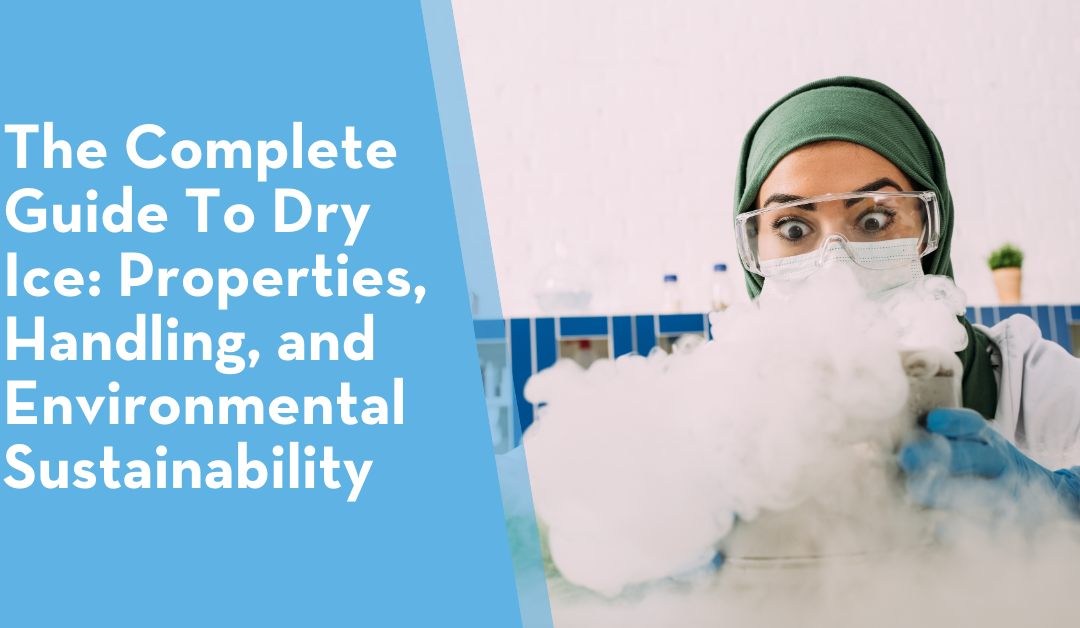Dry ice is far from just a novelty used in fog machines at parties. It plays a crucial role in various industries, from food preservation and pharmaceuticals to scientific research. But what exactly is dry ice, and how does it differ from the ice cubes in your freezer? What makes it a more reliable, environmentally friendly cooling solution than traditional cooling agents?
We answer all these essential questions and more in this comprehensive guide:
- What Is Dry Ice?
- Does Dry Ice Melt or Evaporate?
- How Do You Handle Dry Ice Safely?
- What Are the Environmental Benefits of Dry Ice?
What Is Dry Ice?
Put simply, dry ice is the solid form of carbon dioxide (CO2). It is made by reducing the temperature of carbon dioxide gas to at least -109.3°F (-78.5°C). At this temperature, carbon dioxide transitions from a gas to a solid state, bypassing the liquid stage entirely – a process called deposition.
Dry ice is also much colder than traditional water ice, making it an excellent refrigerant. It is typically sold in blocks or pellets, but some suppliers also offer custom-cut sizing for specific purposes, like airline-cut dry ice.
Common Commercial and Industrial Uses of Dry Ice
Dry ice is utilized across various sectors for its cooling and freezing capabilities, among other practical uses.
1. Temperature-Controlled Distribution
Food, pharmaceuticals, and other perishables require strict temperature control during transit. Dry ice is a reliable cooling agent often used when distributing such products, as it can maintain a low temperature for extended periods without mechanical cooling. Moreover, it ensures the cargo remains dry, preventing moisture-based damage and risks of spoilage.
2. Industrial Cleaning
Dry ice, specifically high-density dry ice pellets, is also used in dry ice blasting for commercial and industrial cleaning projects.
Unlike sandblasting or water blasting, which are often messy, dry ice sublimates on contact so it doesn’t leave behind any residue. It’s also non-abrasive and non-conductive, making it suitable for cleaning equipment and machinery without causing damage or necessitating lengthy drying times.
3. Food Processing
Dry ice is critical as a cooling agent in the food processing industry. It can be used to flash-freeze food products, keeping them fresher for longer and preserving their taste, texture, and nutritional value.
Dry ice is also used as a backup solution for preserving food during power outages or equipment failures. Products like 5 lb. Dry Ice Blocks can deliver impressive cooling power and provide an essential safeguard for food inventory.
4. Airline Catering
Airlines rely on dry ice to preserve in-flight meals at the correct temperatures. Given the limited space and equipment on aircraft, it provides a practical solution that is both space-efficient and reliable for maintaining food freshness.
5. Scientific Research and Laboratories
The scientific community relies on dry ice for various purposes. In research and laboratory settings, dry ice is essential in maintaining low temperatures to preserve biological samples without the risk of freezer burn that can occur with regular ice. It’s also frequently used to transport substances that must remain frozen, like vaccines, tissues, and other medical specimens.
6. Special Effects
Beyond practical applications, dry ice is also widely used in the entertainment industry to create atmospheric effects. When placed in water, dry ice sublimates more rapidly, producing a dense, ground-hugging fog perfect for creating a spooky ambiance or dramatic visual settings in movies and theater productions.
Unlike artificial fog machines that may use chemicals, dry ice is non-toxic and dissipates completely, leaving no residue.
Does Dry Ice Melt or Evaporate?
To answer this question, it helps to clarify that dry ice does not “melt” when exposed to warmer temperatures. Instead, it undergoes a process known as sublimation.
Sublimation occurs when a solid turns directly into a gas without passing through a liquid phase, which we call melting. So, instead of asking, “Does dry ice evaporate or melt?” it’s more accurate to say that it sublimates or turns directly back into carbon dioxide gas as it warms up. This property means it doesn’t leave behind liquid waste, making it a clean and efficient solution for the applications enumerated earlier.
Handling Dry Ice During and After Use: Tips for Safe Handling, Storage, and Disposal
Understanding what dry ice is and how it changes phase as it warms up is crucial for ensuring safe applications. Knowing it has frigid temperatures and turns directly into a gas can inform proper handling and storage solutions.
On that note, here are six crucial tips to safely handle, store, and dispose of dry ice.
1. Use Proper Personal Protective Equipment (PPE)
Dry ice can cause frostbite, cold burns, and severe skin damage. Always use insulated gloves when handling dry ice to protect your hands. It’s also best to wear safety goggles to shield your eyes from any potential CO2 exposure that could irritate them.
2. Ensure Proper Ventilation When Storing or Moving Dry Ice
Store your dry ice in well-ventilated areas to help maintain a safe oxygen level and prevent carbon dioxide gas buildup. Sublimation can displace oxygen, depleting breathable air in enclosed spaces and leading to suffocation risks or breathing difficulties for people nearby.
The same applies when transporting dry ice. Using well-ventilated vehicles can help maintain optimal airflow and allow CO2 to dissipate safely into the atmosphere.
3. Monitor Carbon Dioxide Levels
Besides ensuring proper ventilation, monitor the CO2 levels in the areas where you store your dry ice. Use carbon dioxide monitors and detectors to continuously track CO2 concentrations and receive alerts when they rise above the alarm set point.
It’s also a good idea to use vented coolers or Styrofoam containers. These keep dry ice cold while allowing gas to escape during sublimation.
4. Let It Sublimate Naturally
The safest way to dispose of dry ice is to let the sublimation process occur naturally. Find a well-ventilated area at room temperature where the dry ice can dissipate safely into the atmosphere. This eliminates the risks associated with improper handling, like burns or respiratory issues.
5. Never Flush Dry Ice Down Drains, Sinks, or Toilets
Flushing dry ice down any drain is a recipe for disaster. Its extremely cold temperature can damage pipes, causing them to freeze, crack, or burst. Moreover, as dry ice sublimates, it can create a buildup of gas and pressure inside your plumbing system, creating the risk of explosions.
6. Be Prepared for Accidental Exposure
In case of accidental skin contact with dry ice, rinse the affected area with cold water as soon as possible as first aid. However, don’t attempt to treat severe cold burns yourself. Seek professional medical help if any burns or irritation develop.
If you suspect exposure to sublimated gas, watch out for these symptoms: breathing difficulty, dizziness, confusion, and a rapid heartbeat. If you or anyone else begins to experience any of these, quickly move to an area with better ventilation for fresh air. Should these symptoms persist or worsen, seek medical attention immediately.
The Environmental Benefits of Dry Ice
One of the most significant benefits of dry ice is its reduced environmental impact compared to traditional refrigeration methods. It goes directly from solid to gas without producing liquid waste when it sublimates, minimizing the risk of soil and water pollution. Its direct transition to gas also leaves no residue, eliminating disposal concerns associated with typical refrigerants.
It’s also worth noting that plants can convert the carbon dioxide released during sublimation back into oxygen through photosynthesis. This cycle allows for an environmentally friendly disposal method that doesn’t contribute to landfill waste, making dry ice a more sustainable choice for temperature control.
Get Top-Tier Dry Ice Solutions for Various Applications at Emory
Whether you’re in the food industry, a scientific field, or the world of entertainment, a reliable, high-quality dry ice supply is crucial to your operations. This is where Emory steps in.
At Emory, we’re dedicated to providing the highest quality dry ice products that benefit your enterprise, research, or event. We understand the diverse dry ice applications and offer tailored solutions for each sector we serve. Best of all, we comply with the rigorous standards set by the U.S. Food and Drug Administration to deliver safety and quality in each of our dry ice products.
Explore the possibilities with Emory Dry Ice today. Get in touch for pricing details or the customized solutions we can offer.






